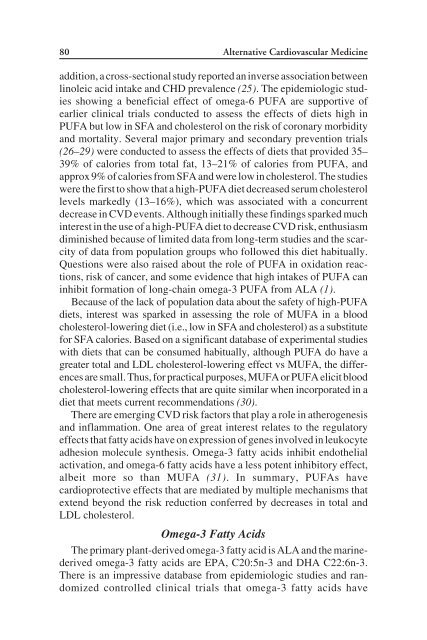Complementary Alternative Cardiovascular Medicine
Complementary Alternative Cardiovascular Medicine
Complementary Alternative Cardiovascular Medicine
You also want an ePaper? Increase the reach of your titles
YUMPU automatically turns print PDFs into web optimized ePapers that Google loves.
80 <strong>Alternative</strong> <strong>Cardiovascular</strong> <strong>Medicine</strong><br />
addition, a cross-sectional study reported an inverse association between<br />
linoleic acid intake and CHD prevalence (25). The epidemiologic studies<br />
showing a beneficial effect of omega-6 PUFA are supportive of<br />
earlier clinical trials conducted to assess the effects of diets high in<br />
PUFA but low in SFA and cholesterol on the risk of coronary morbidity<br />
and mortality. Several major primary and secondary prevention trials<br />
(26–29) were conducted to assess the effects of diets that provided 35–<br />
39% of calories from total fat, 13–21% of calories from PUFA, and<br />
approx 9% of calories from SFA and were low in cholesterol. The studies<br />
were the first to show that a high-PUFA diet decreased serum cholesterol<br />
levels markedly (13–16%), which was associated with a concurrent<br />
decrease in CVD events. Although initially these findings sparked much<br />
interest in the use of a high-PUFA diet to decrease CVD risk, enthusiasm<br />
diminished because of limited data from long-term studies and the scarcity<br />
of data from population groups who followed this diet habitually.<br />
Questions were also raised about the role of PUFA in oxidation reactions,<br />
risk of cancer, and some evidence that high intakes of PUFA can<br />
inhibit formation of long-chain omega-3 PUFA from ALA (1).<br />
Because of the lack of population data about the safety of high-PUFA<br />
diets, interest was sparked in assessing the role of MUFA in a blood<br />
cholesterol-lowering diet (i.e., low in SFA and cholesterol) as a substitute<br />
for SFA calories. Based on a significant database of experimental studies<br />
with diets that can be consumed habitually, although PUFA do have a<br />
greater total and LDL cholesterol-lowering effect vs MUFA, the differences<br />
are small. Thus, for practical purposes, MUFA or PUFA elicit blood<br />
cholesterol-lowering effects that are quite similar when incorporated in a<br />
diet that meets current recommendations (30).<br />
There are emerging CVD risk factors that play a role in atherogenesis<br />
and inflammation. One area of great interest relates to the regulatory<br />
effects that fatty acids have on expression of genes involved in leukocyte<br />
adhesion molecule synthesis. Omega-3 fatty acids inhibit endothelial<br />
activation, and omega-6 fatty acids have a less potent inhibitory effect,<br />
albeit more so than MUFA (31). In summary, PUFAs have<br />
cardioprotective effects that are mediated by multiple mechanisms that<br />
extend beyond the risk reduction conferred by decreases in total and<br />
LDL cholesterol.<br />
Omega-3 Fatty Acids<br />
The primary plant-derived omega-3 fatty acid is ALA and the marinederived<br />
omega-3 fatty acids are EPA, C20:5n-3 and DHA C22:6n-3.<br />
There is an impressive database from epidemiologic studies and randomized<br />
controlled clinical trials that omega-3 fatty acids have


